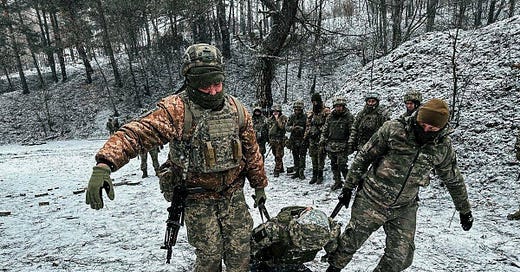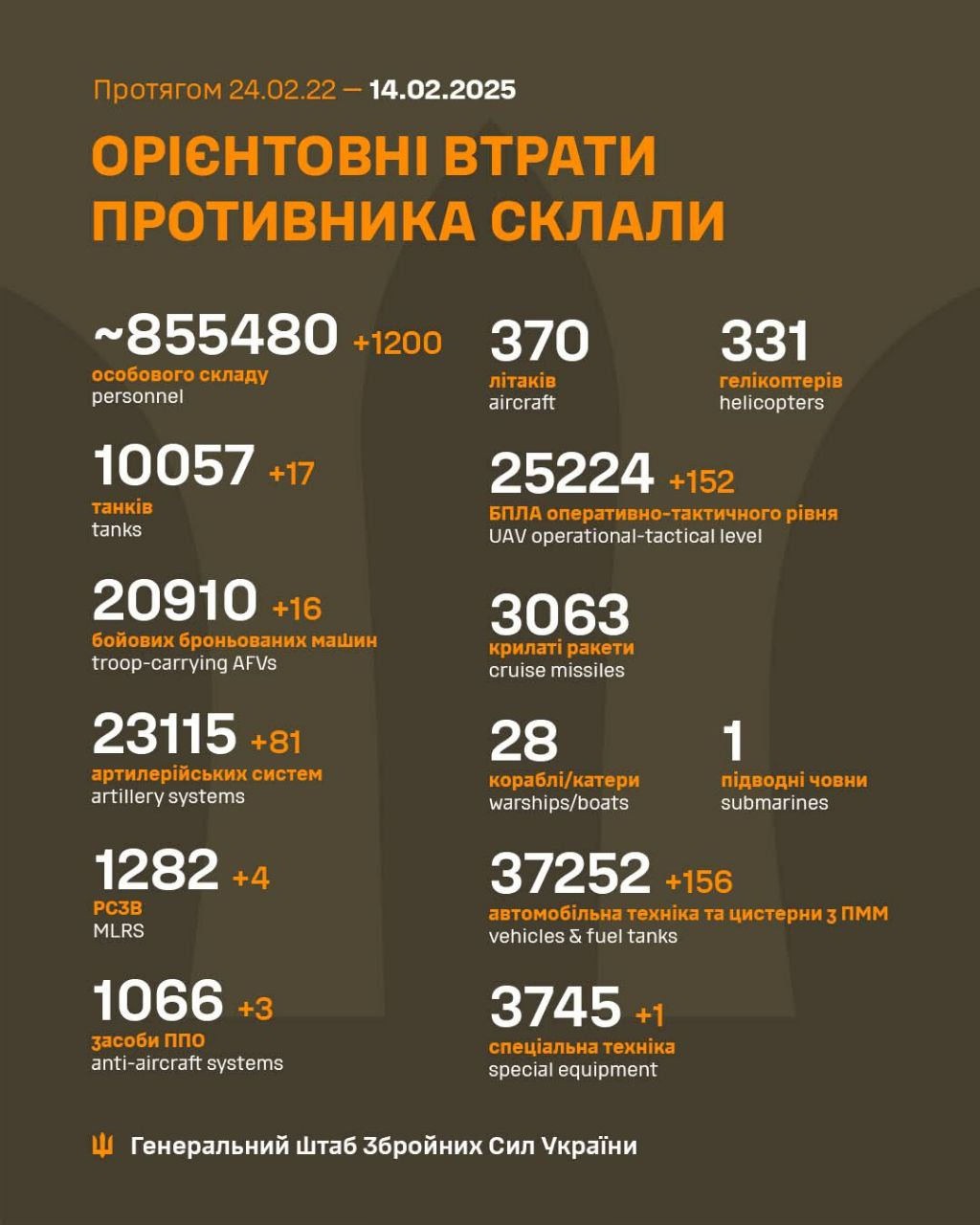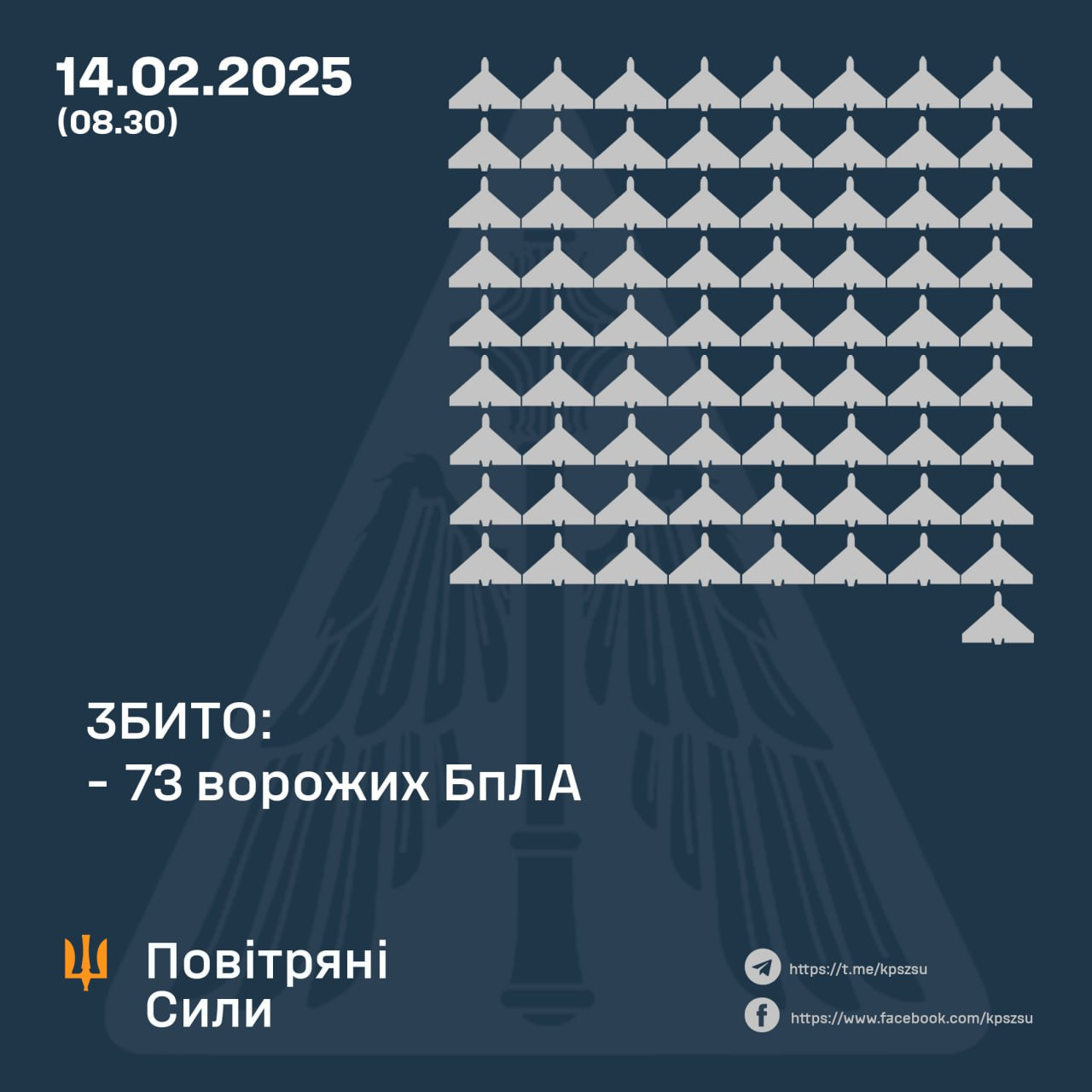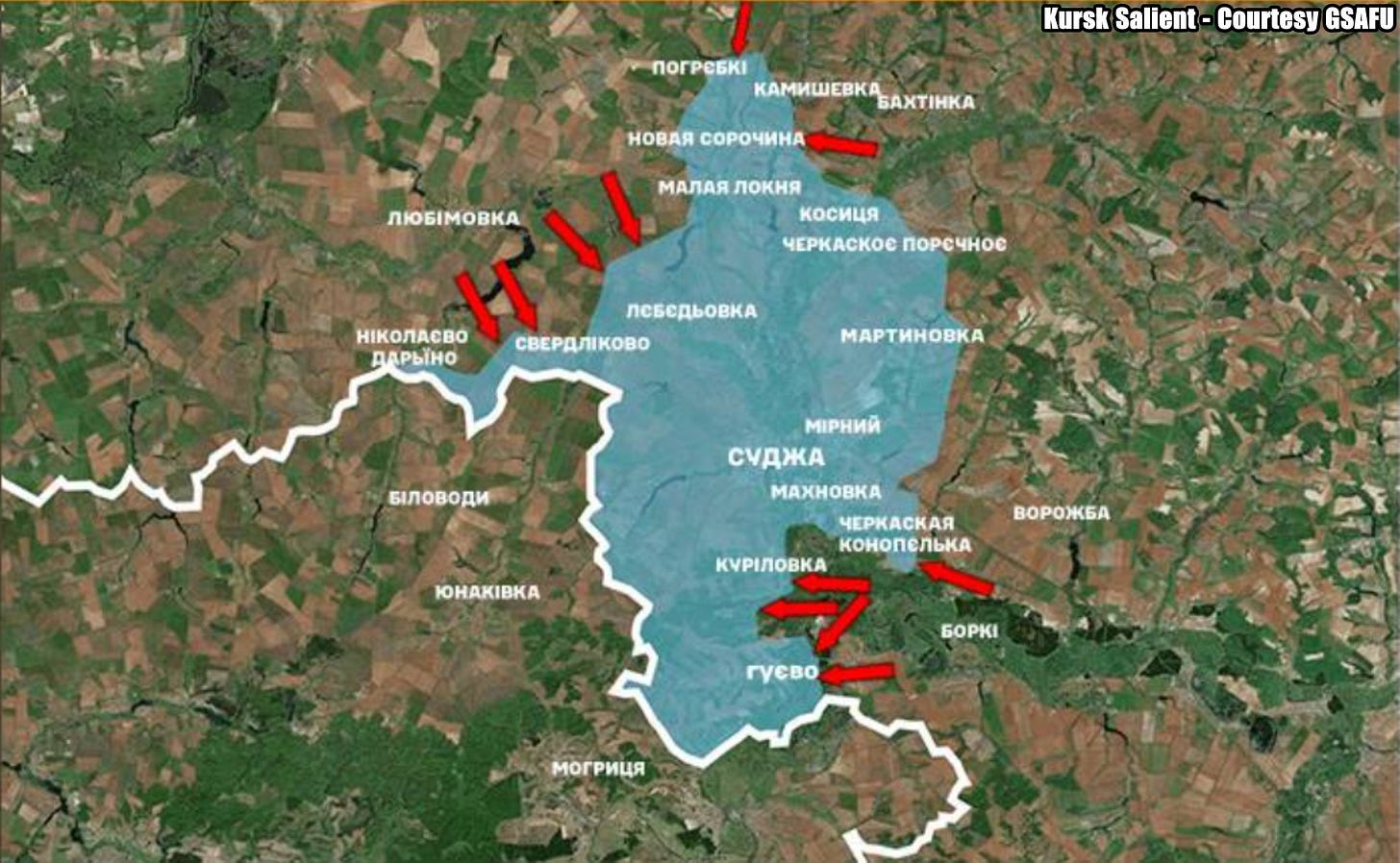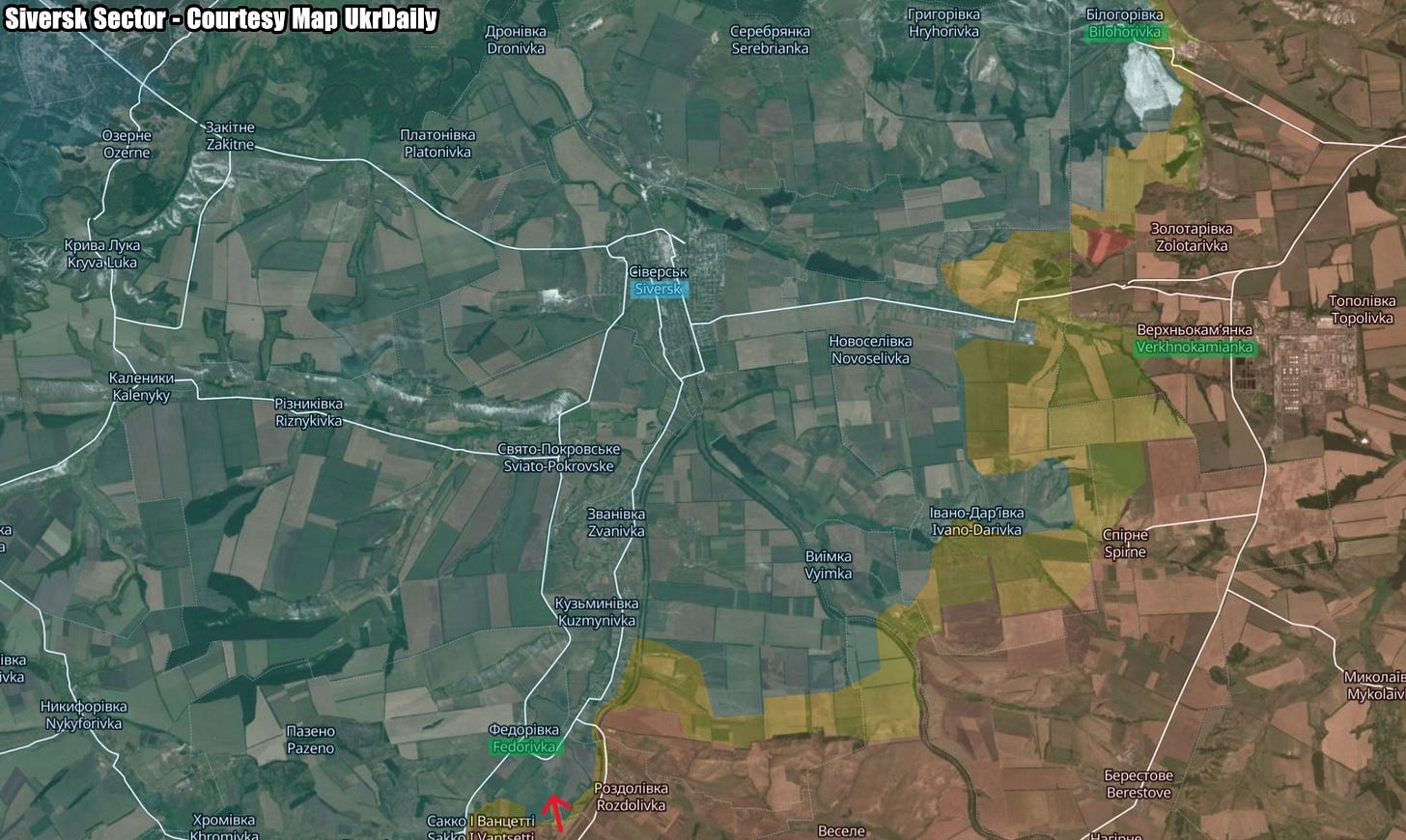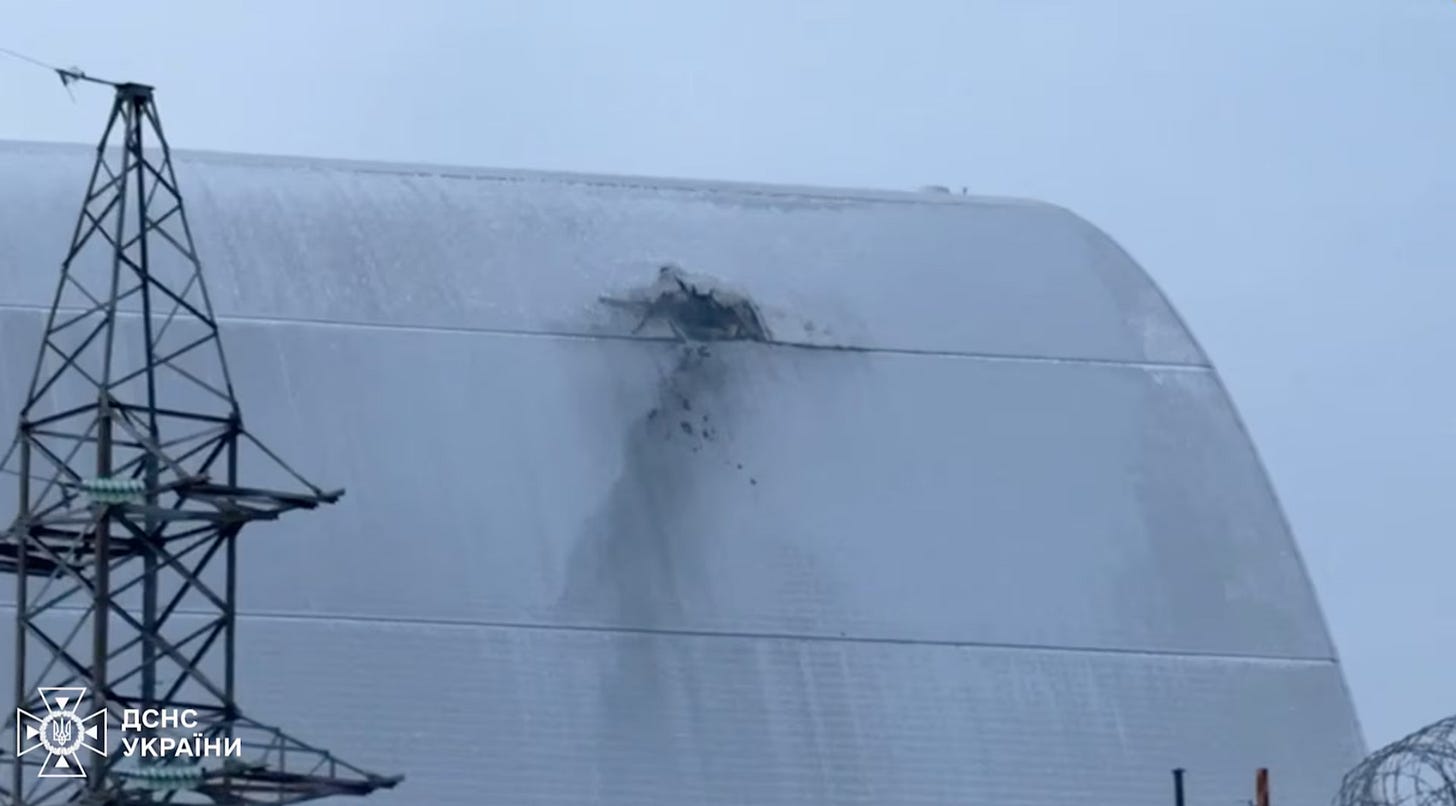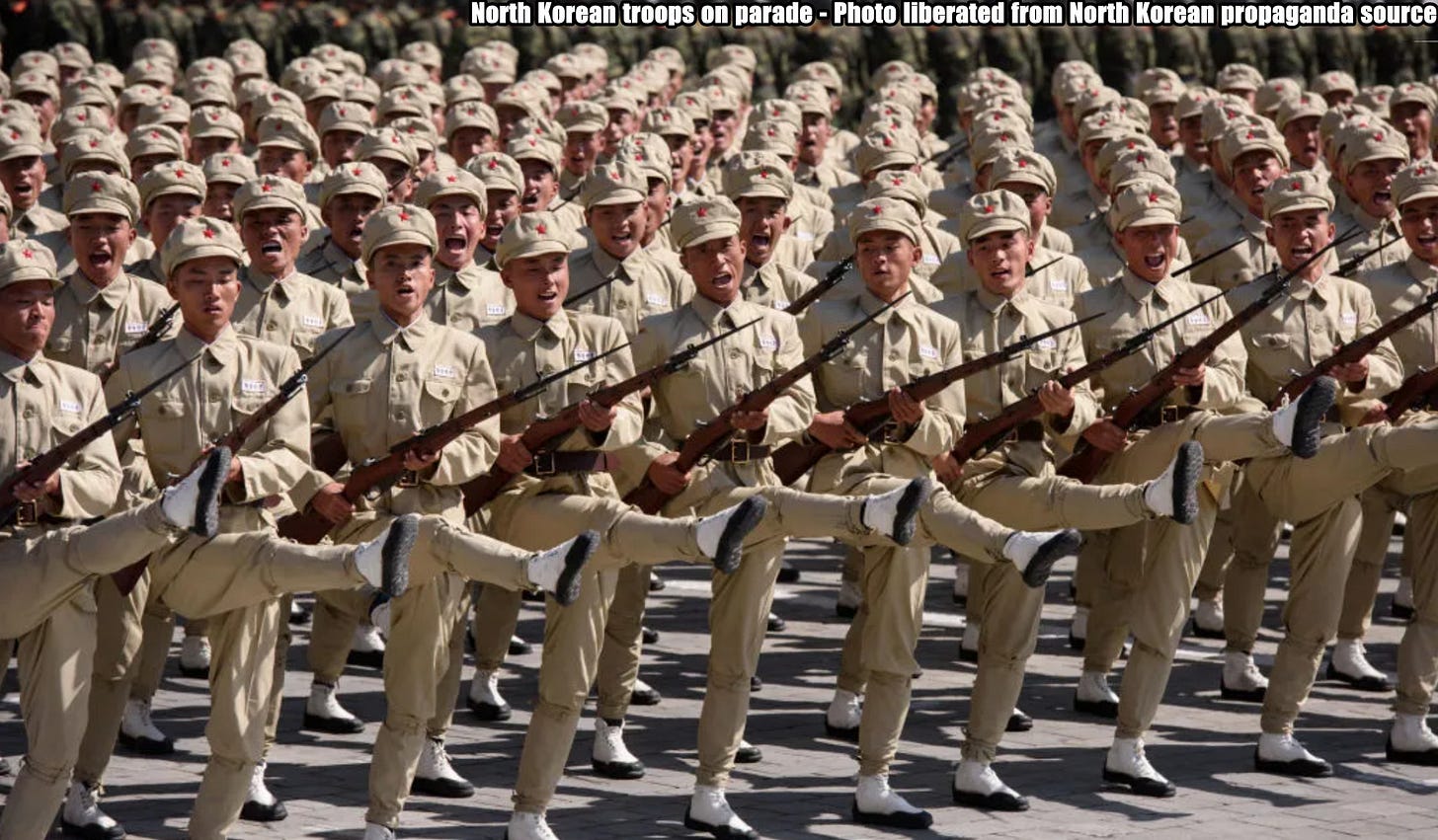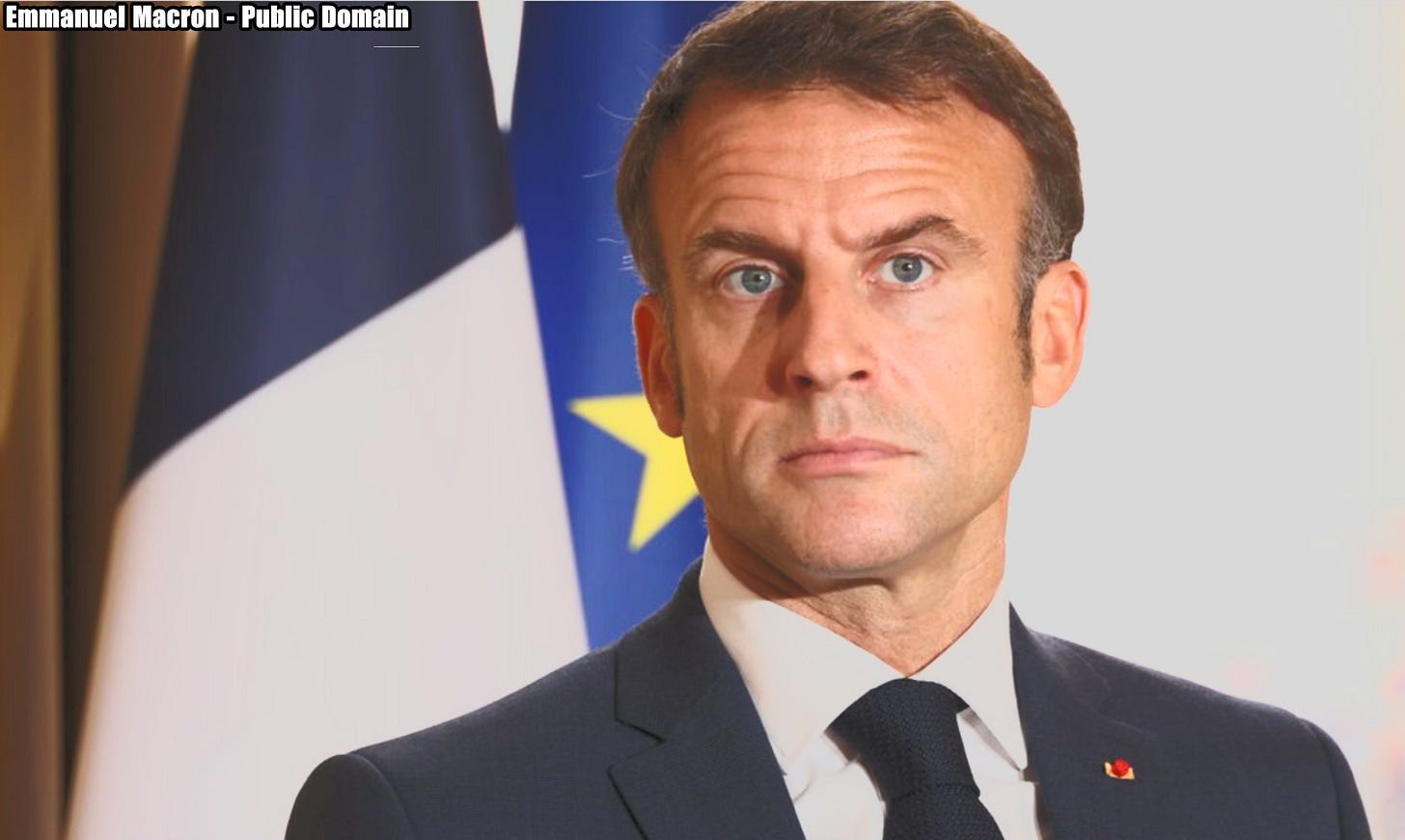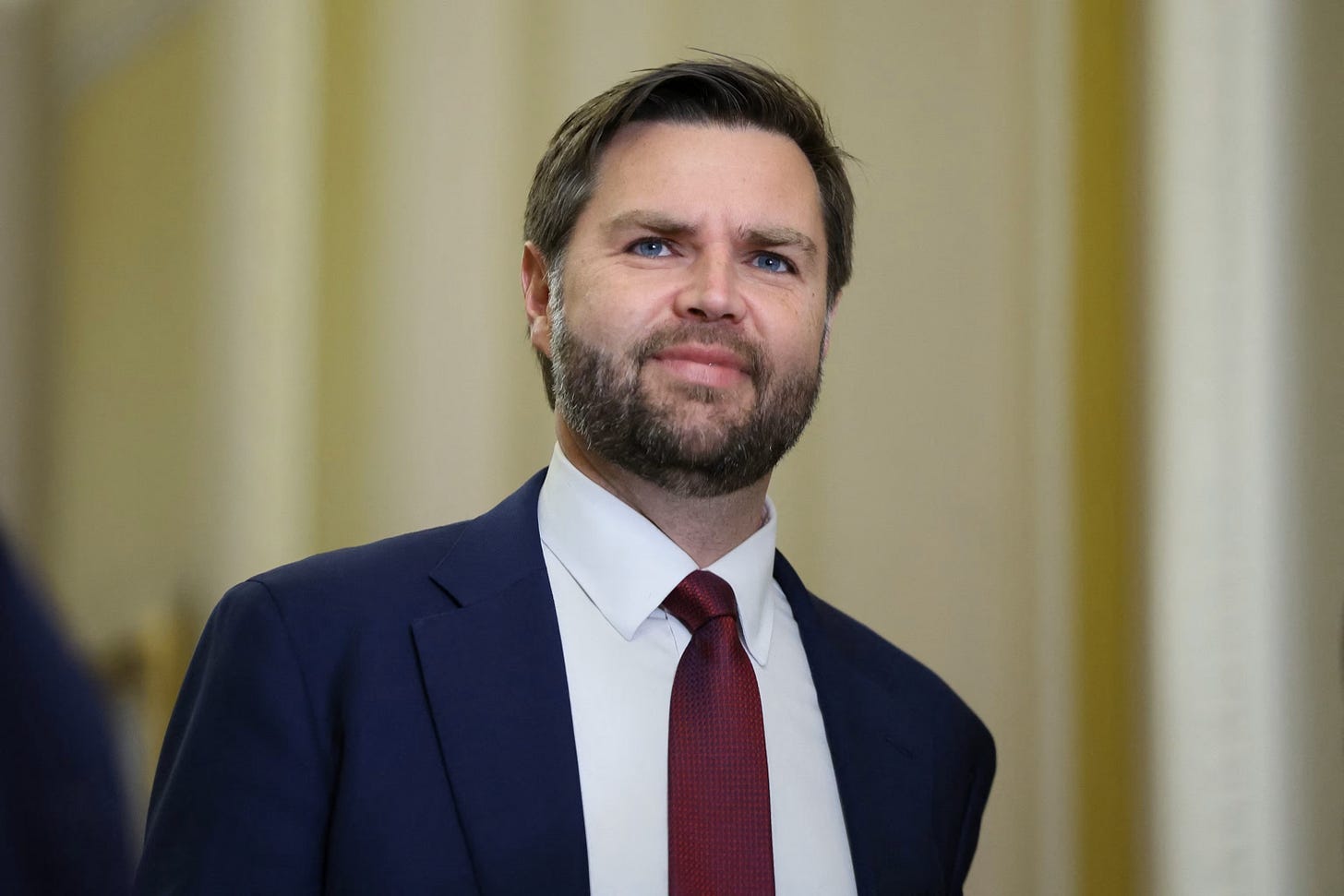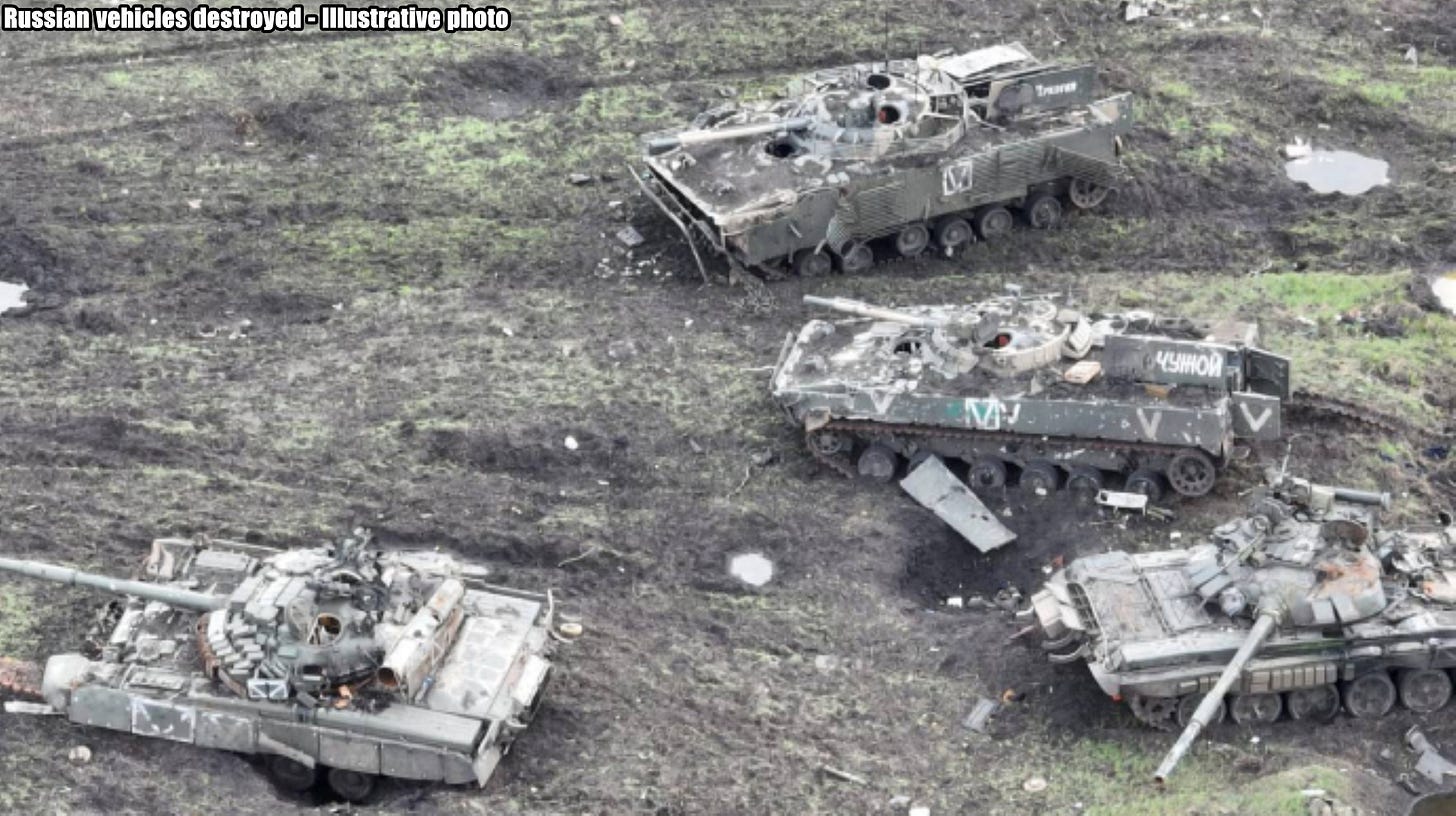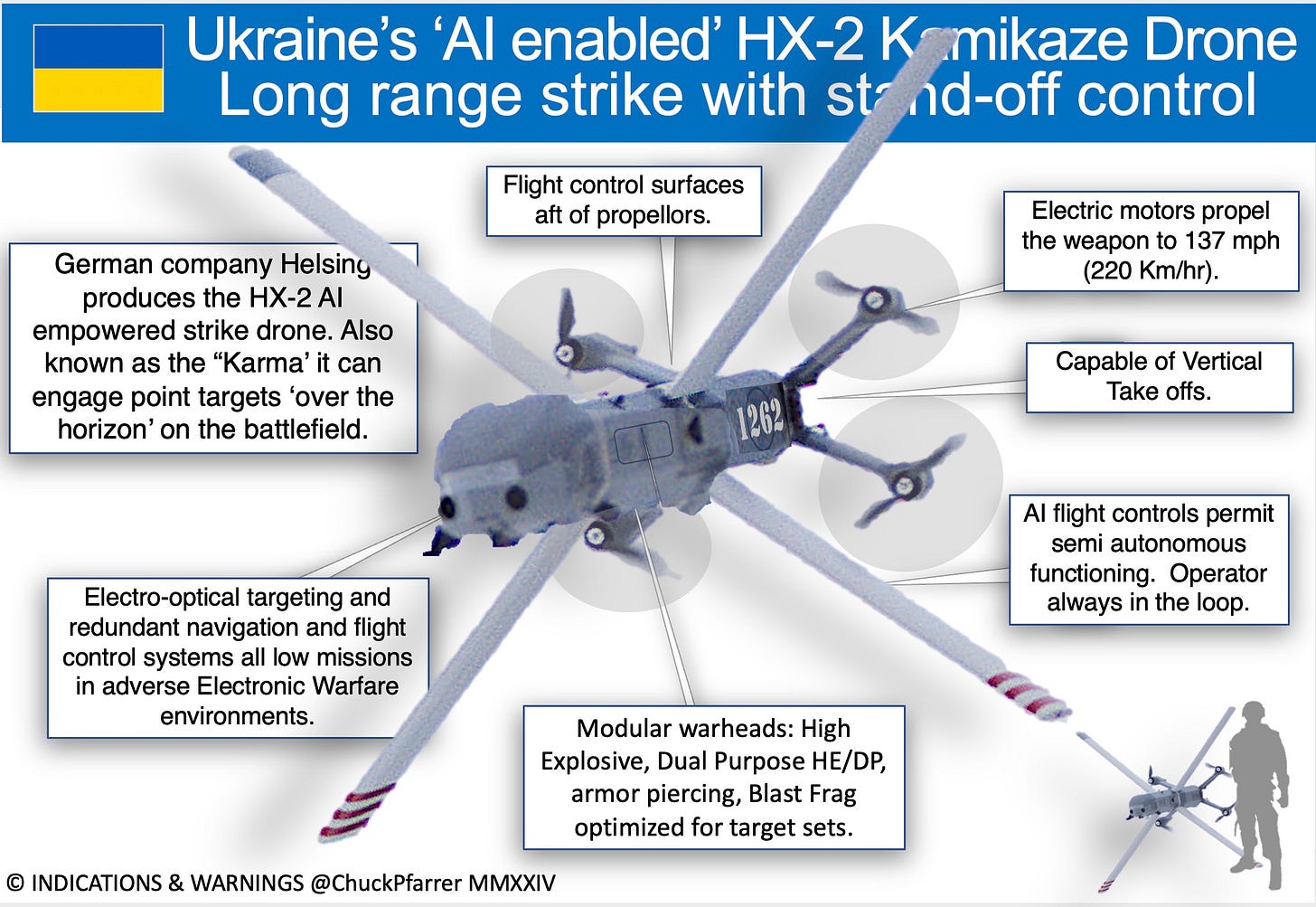Slava Ukraini! In early 2022 I began a Telegram channel aggregating news from a number of sources daily on the war in Ukraine. In June 2023 I began providing a daily draft for the Ukraine War Brief Podcast collecting news from over 70 sources daily, which formed the basis of the script. While the Podcast no longer exists I have continued to make this Brief available for my followers here on Substack for those who wish to keep up with the news from the war.
All the latest news on the Russo-Ukraine War 6 days per week
ALONG THE CONTACT LINE
GSAFU Morning Report
The General Staff of the Armed Forces of Ukraine in its Operational Information update at 08:00 on Feb 14 stated that day 1087 of the full-scale invasion of the Russian Federation against Ukraine had begun.
The situation on the line of combat remains tense in some sectors. Ukrainian defenders continue to actively counteract the Russian aggressor, causing them significant losses in personnel, equipment and technology. Exhausting the enemy along the entire front line and continuing to disrupt the plans of Russian occupiers to advance deeper into the territory of Ukraine.
During the past day, 113 combat engagements took place.
Over the past 24 hours, the enemy carried out 2 missile strikes, 89 air strikes and fired approximately 6,000 artillery shells across the positions of Ukrainian forces and civilians.
Air Force Daily Report
73 ENEMY UAVS SHOT DOWN, 58 DRONES FAILED TO REACH THEIR TARGETS (LOCATIONALLY LOST)
➖➖➖➖➖➖➖➖➖
On the night of February 14, 2025 (from 7:30 p.m. on February 13), the enemy attacked with 133 Shahed-type strike UAVs and simulator drones of various types from the directions: Millerovo, Kursk, Bryansk, Shatalovo, Primorsko-Akhtarsk - Russia.
The air attack was repelled by aviation, anti-aircraft missile troops, electronic warfare units, and mobile fire groups of the Air Force and Defense Forces of Ukraine.
As of 08:30, it was confirmed that 73 Shahed attack UAVs and drones of other types were shot down in Kharkiv, Poltava, Sumy, Cherkasy, Chernihiv, Kirovohrad, Zhytomyr, Khmelnytskyi, Zaporizhia, Mykolaiv, and Odessa regions.
58 enemy drone simulators were lost in location (without negative consequences).
As a result of the enemy attack, the Kyiv, Sumy, Chernihiv, Odesa, and Kharkiv regions suffered
Combat Operations in the Kursk Sector, Russian Federation
The Institute for the Study of War (ISW), a US based think tank, in its -- Russian Offensive Campaign Assessment reported that Fighting continued in the Ukrainian salient in Kursk Oblast on Feb 13. Russian milbloggers claimed that fighting continues west of Sudzha near Sverdlikovo and southeast of Sudzha near Cherkasskaya Konopelka. A Russian milblogger claimed on Feb 13 that Ukrainian forces counterattacked near Kurilovka (south of Sudzha).
The Khortytsia operational-strategic group
(Responsible for the northeastern part of Ukraine. )
Borova Sector: Russian forces recently advanced in the Borova direction. Russian forces attacked northeast of Borova near Kolisnykivka, Zahryzove and Lozova; east of Borova near Kopanky; and southeast of Borova near Hrekivka and Novomykhailivka on Feb 12 and 13.
The Ukrainian General Staff published a map on Feb 13 indicating that Russian forces likely recently advanced in fields west of Pershotravneve (east of Borova).
Siversk Sector: Russian forces recently advanced near Siversk. Russian forces continued attacks northeast of Siversk near Bilohorivka and east of Siversk near Verkhnokamyanske on Feb 12 and 13.[41]
The Ukrainian General Staff published a map on Feb 13 indicating that Russian forces likely recently advanced southeast of Fedorivka (south of Siversk).
The Tavria operational-strategic group
(Responsible for the central-eastern and southeastern part of Ukraine.)
Pokrovsk Sector : Russian forces continued offensive operations in the Pokrovsk direction on Feb 13 but did not advance.
Russian forces attacked east of Pokrovsk near Zelene Pole, Vodyane Druhe, Tarasivka, Yelyzavetivka, Malynivka, and Promin; southeast of Pokrovsk near Lysivka; south of Pokrovsk near Zvirove and Pishchane; southwest of Pokrovsk near Udachne, Nadiivka, Zaporizhzhia, Preobrazhenka, and Uspenivka on Feb 12 and 13.
The Odesa operational-strategic group
(Responsible for Kherson, Qırım, (also known as Crimea) and the Black Sea.)
There have been no major changes to the combat environment since our last report.
TEMPORARILY OCCUPIED TERRITORIES
Nothing major to report.
THE HOME FRONT
Russia attacks Chornobyl NPP with kamikaze drone
Russian troops attacked the Chornobyl nuclear power plant with a Shahed-type kamikaze drone called 'Geran-2,' equipped with an explosive warhead and wreckage of the Russian drone has been found, Censor.NET reports citing the Security Service of Ukraine.
Inside and near the shelter, the SSU found the wreckage of a Russian drone body with a warhead and serial number.
It has been established that the occupiers attacked the Chornobyl NPP with a kamikaze drone called Geranium-2 of the Shahed type. To maximise firepower, this attack drone was equipped with an explosive warhead. According to experts, the Russians deliberately targeted this particular facility.
The Security Service of Ukraine announced the opening of criminal proceedings over the Russian attack on the shelter of Chornobyl NPP Unit 4. Relevant authorities are working at the scene. The pre-trial investigation is ongoing under Article 438 of the Criminal Code of Ukraine (violation of the laws and customs of war).
Ukraine opens criminal cases against ex-President Poroshenko, sanctioned oligarchs.
Prosecutor General's Office announced on Feb. 14 that criminal proceedings have been opened against businessmen and former high-ranking officials recently sanctioned by the National Security and Defense Council (NSDC), the Kyiv Independent reports.
The list includes oligarch Ihor Kolomoisky, billionaire Konstantin Zhevago, former PrivatBank co-owner Hennadiy Boholyubov, Ukraine's 5th President Petro Poroshenko, and former pro-Russian lawmaker Viktor Medvedchuk.
"Each of these five individuals is being held criminally liable for committing serious and especially serious crimes," the Prosecutor General's Office said in a post on Telegram.
Poroshenko was charged in 2021 with high treason and aiding terrorist organizations for allegedly conspiring with Russian-backed separatists between November 2014 and January 2015. The scheme reportedly generated over Hr 3 billion ($72 million) in profits from coal supplies.
He said the decision to impose sanctions against him was politically motivated and unconstitutional.
Medvedchuk faces charges of high treason and violations of war laws, accused of helping Russia seize a Ukrainian oil and gas field in the Black Sea's Kerch Shelf.
He is also accused of passing secret military information, including the locations of Ukrainian military units, and creating a pro-Russian influence network in Ukraine.
Kolomoisky is under investigation for embezzling over Hr 5.36 billion ($129 million) from a financial institution and laundering nearly Hr 4.1 billion ($99 million).
He is suspected of orchestrating the contract killing of a legal company director who refused to annul a decision regarding a shareholders' meeting.
Zhevago is suspected of embezzling $113 million and misappropriating Hr 608 million ($15 million) from a Ukrainian bank through a conspiracy with bank officials.
This illegal transfer of funds to offshore accounts caused major financial losses to the institution. He is also under investigation for involvement in a criminal organization and money laundering.
Boholyubov is being investigated for illegal possession of another person's passport and organizing an unlawful border crossing with the help of a border guard. He is wanted by Ukrainian authorities for his role in aiding illegal border crossings.
The sanctions freeze all assets held by the targeted individuals in Ukraine and block them from conducting financial transactions, among other restrictions. The decree states that the measures are indefinite.
RUSSIAN WORLD
North Korea suffers 4,000 casualties in Russia's Kursk Oblast, 2/3 killed.
North Korean troops fighting for Russia against Ukraine have suffered 4,000 casualties, two-thirds of whom have been killed, the Kyiv Independent reported quoting President Volodymyr Zelenskyy on Feb. 14.
Speaking at the Munich Security Conference, Zelenskyy said the morale of Pyongyang's troops had been "broken" by the losses, a Kyiv Independent journalist reported from the event.
"We understand that their losses are more than four thousand. I think two-thirds have died," he added.
Up to 12,000 North Korean troops were deployed to Kursk Oblast last fall to support Russian forces in countering a Ukrainian incursion launched in early August 2024.
Zelensky's claim of the number killed is significantly higher than a Jan. 13 estimate from South Korea's National Intelligence Service (NIS) which said at least 300 North Korean soldiers have been killed and another 2,700 wounded.
Zelensky also said 2,000-3,000 more troops are being transferred from North Korea to Russia's Kursk Oblast, saying it was important that U.S. President Donald Trump takes note of such developments as he tries to bring Moscow to the negotiating table.
The heavy losses of the North Korean army may be related to its lack of combat experience and the tactic of human waves attacks with a limited amount of equipment, Ukraine's military intelligence chief Kyrylo Budanov said in an interview with The War Zone magazine published on Feb. 4.
According to Budanov, North Korean soldiers attack "almost without any combat vehicles."
Budanov also suggested that the North Korean military is so willing to advance on foot against Ukrainian drones and artillery because of its loyalty to North Korean dictator Kim Jong-un.
He added their disregard for personal safety makes Ukraine's defense more challenging.
INTERNATIONAL NEWS
Macron says only Ukrainian President Zelenskiy can negotiate peace for his country.
French President Emmanuel Macron said only Ukrainian President Volodymyr Zelenskiy could negotiate on behalf of his country with Russia to end the war, warning a "peace that is a capitulation" would be "bad news for everyone", including the U.S., the Financial Times reported on Thursday. Reuters reports.
"The only question at this stage is whether President Putin is genuinely, sustainably, and credibly willing to agree to a ceasefire on this basis. After that, it’s up to the Ukrainians to negotiate with Russia,” Macron said in an interview with the newspaper at the Elysee Palace.
U.S. President Donald Trump on Wednesday separately discussed the war with Russian President Vladimir Putin and Zelenskyy and told U.S. officials to begin talks on ending the nearly three-year-long conflict.
Ukrainians on Thursday worried that Trump was preparing to sell out their country following his phone call Putin.
Trump, speaking to reporters at the White House on Thursday, said Ukraine would have a seat at the table during any peace negotiations with Russia over ending the war.
Macron told the Financial Times that Trump had created a “window of opportunity” for a negotiated solution, where "everyone has to play their role", adding that it is now up to Zelenskyy to discuss territorial and sovereignty issues.
He said "..it is up to the international community, with a specific role for the Europeans, to discuss security guarantees and, more broadly, the security framework for the entire region. That is where we have a role to play."
Macron described Trump’s return as an "electroshock" that should force Europe to secure its own future as well as Ukraine’s, the Financial Times report added.
Separately, Macron said to the newspaper that expelling Gazans would be “extremely dangerous”, adding that Trump’s designs on Gaza and Greenland were examples of the "extreme strategic uncertainty" the world was now living in.
The commentary is aimed at Trump's shock announcement that the U.S. intends to remove Gaza residents and transform the war-ravaged territory into what the president billed as a "Riviera of the Middle East". He had also said he wants to take over the Panama Canal and Greenland.
Macron reiterated that Europe should build its defence capabilities so it can act even when the U.S. is not involved.
“We must also develop a fully integrated European defence, industrial and technological base,” Macron said.
In January, at a joint news conference with German Chancellor Olaf Scholz in Paris, Macron said: "After the inauguration of a new administration in the United States, it is necessary more than ever for Europeans and for our two (France and Germany) countries to play their role of consolidating a united, strong and sovereign Europe."
Zelenskyy-Vance meeting postponed as US reviews Ukraine's partnership draft.
The meeting between President Volodymyr Zelenskyy and U.S. Vice President JD Vance at the Munich Security Conference has been postponed to allow the U.S. time to review a draft memorandum of partnership submitted by Kyiv, a source in the Zelensky's Office reported to the Kyiv Independent on Feb. 14.
The postponement comes as the U.S. considers a proposed minerals agreement that could link future aid to Ukraine with access to its rare earth mineral reserves.
U.S. Treasury Secretary Scott Bessent delivered a draft of the agreement to Zelenskyy during a visit to Kyiv on Feb. 12. Ukraine finalized and handed over the memorandum to the U.S. side, which requested additional time to review the document until 5 p.m.
During his press conference, Zelenskyy confirmed that the meeting with Vance would take place later in the day.
The draft memorandum is part of broader discussions on a potential minerals agreement, which U.S. President Donald Trump has suggested could involve access to Ukraine's mineral reserves in exchange for continued military and financial support.
Zelenskyy has expressed openness to such an arrangement, saying that Ukraine is willing to grant U.S. companies access to minerals in exchange for sustained support from Washington.
The proposed minerals agreement could mark a significant shift in U.S.-Ukraine relations, tying economic cooperation to security assistance.
Grumpy Here - I have it on good authority the real reason they had to postpone the meeting was they had to send out for extra plastic to cover the couches…
MILITARY & TECH
Russia cannot produce tanks and armored vehicles at the rate it is losing them.
The Institute for the Study of War (ISW), a US based think tank, in its Feb 13 Russian Offensive Campaign Assessment reported that Russia reportedly lost just over 5,000 tanks and armored vehicles during 2024 compared with 3,000 in 2023. The British International Institute for Strategic Studies (IISS) estimated on Feb 10 that Russia lost 1,400 main battle tanks (roughly four tank divisions' worth) and over 3,700 infantry fighting vehicles (IFVs) and armored personnel carriers (APCs) — totaling 5,100 lost tanks and armored vehicles in 2024. Data from the Ukrainian General Staff indicates that Ukrainian forces damaged or destroyed over 3,000 Russian tanks and almost 9,000 armored vehicles in 2024, and IISS' estimates likely only account for destroyed tanks and armored vehicles. IISS assessed in Feb 2024 that Russia would be able to sustain its then-rate of vehicle losses (over 3,000 tanks, APCs, and IFVs annually as of 2023) until Feb 2026 or 2027 by refurbishing vehicles from Soviet-era storage facilities. It remains unclear if the Russian military command will remain willing or able to sustain this increased rate of armored vehicle losses in 2025, as Russian forces appear to be adapting their tactics to limit such losses.
IISS noted that Russia has adapted some of its tactics to address ongoing equipment shortages and is increasingly relying on infantry-led assaults to advance along the frontline. ISW began observing indications in Nov and Dec 2024 that Russian forces were using fewer armored vehicles in Donetsk Oblast, particularly in areas where Russian forces had previously relied heavily on mechanized assaults to make significant tactical advances. Russian forces have continued to use fewer armored vehicles in Donetsk Oblast and throughout the frontline, possibly due to Ukrainian drone operations, equipment constraints, or non-conducive ground conditions brought about by rainy weather. Khortytsia Group of Forces Spokesperson Major Viktor Trehubov stated on Feb 13 that successful Ukrainian drone strikes have been the main factor — and not poor weather and ground conditions — prompting Russian forces to use fewer armored vehicles along the frontline. Trehubov noted that Russian forces also have issues supplying shells to some unspecified frontline positions, possibly due to successful Ukrainian strikes against Russian ammunition depots, and have thus decreased the intensity of shelling in such areas.
It remains unclear if Russia can repair and newly-produce a sufficient number of tanks and armored vehicles to replace losses in Ukraine and equip new Russian units. IISS assessed that Russia refurbished and built over 1,500 tanks and 2,800 IFVs and APCs in 2024 — suggesting that Russia produced enough vehicles to replace all of its tank losses and three quarters of its armored vehicle losses last year.
IISS assessed that Russia's ongoing effort to expand the Russian military and create new units is exacerbating equipment shortages and noted that Russia may also be suffering from a shortage of spare parts to refurbish tanks and armored vehicles. IISS assessed that it is highly likely that the Soviet-era tanks and armored vehicles remaining in Russia's stores are in a deteriorated condition, which may complicate Russia's ability to offset high equipment losses in 2025 and beyond.
Ukrainian President Volodymyr Zelenskyy, citing Ukrainian intelligence, reported on Feb 8 that Russia is continuing to form new divisions, and former Russian Defense Minister and Security Council Secretary Sergei Shoigu announced in Jan 2023 that Russia aimed to stand up 14 new military divisions in the coming years. The Russian military command appears to be balancing allocating refurbished and newly-produced vehicles between new formations and formations that have been fighting on the frontline for several years. Russia may struggle to adequately equip its units with materiel in the long-term if the Russian military continues to burn through Soviet-era vehicle stocks without significantly increasing Russia's ability to produce new tanks and armored vehicles.
Germany’s Helsing to deliver 6,000 HX-2 strike drones to Ukraine.
Helsing, the German defense technology company, has announced the production of 6,000 HX-2 strike drones for delivery to Ukraine. Defence Blog reports.
This follows a previous order of 4,000 HF-1 strike drones, which are currently being delivered in partnership with Ukrainian industry.
Unveiled in late 2024, the HX-2 is an electrically propelled X-wing precision munition with a range of up to 100 kilometers. The drone features advanced onboard artificial intelligence, enabling full resistance to electronic warfare tactics. When integrated with Helsing’s Altra reconnaissance-strike software, multiple HX-2 drones can operate as a coordinated swarm, controlled by a single operator. Designed for mass production at a significantly lower unit cost than conventional weapons, the HX-2 is intended to address the growing need for precision-strike capabilities in modern land warfare.
In a parallel development, Helsing announced the completion of its first Resilience Factory in Southern Germany. These facilities are designed to provide nation-states with localized and sovereign drone manufacturing capacities, ensuring uninterrupted production in times of conflict. Helsing plans to establish multiple Resilience Factories across Europe, with each capable of scaling production rates to tens of thousands of units as needed.
The first operational Resilience Factory (RF-1) in Southern Germany has an initial monthly production capacity of over 1,000 HX-2 drones. The company expects this capability to significantly enhance Ukraine’s operational effectiveness on the battlefield, particularly in countering Russia’s numerical advantages in conventional military assets.
Gundbert Scherf, co-founder of Helsing, emphasized the strategic importance of scaling up production in response to Ukraine’s evolving defense needs. “We are scaling up production of HX-2 in response to additional orders from Ukraine, where precision mass is offsetting a numerical disadvantage in legacy systems on a daily basis. It is clear that NATO has important lessons to learn, and fast. With our Resilience Factories, we are taking a distributed approach towards mass manufacturing these systems across Europe, allowing individual nation-states to produce locally and ensure sovereignty of production and supply chain.”
Niklas Köhler, also a co-founder of Helsing, highlighted the innovative approach behind the company’s manufacturing strategy. “We have assembled Europe’s world-leading manufacturing talent to completely rethink and develop a new generation of mass-producible effects. Our Resilience Factories combine software-first design with scalable manufacturing techniques. We solve the hard problems in the software layer, not the electronics. This generates affordable precision mass, deters adversaries, and protects our democracies. HX-2 is just the first of a whole range of products based on this premise.
Helsing’s initiative aligns with ongoing efforts to enhance Ukraine’s defense capabilities, with European nations increasingly supporting drone warfare advancements. The HX-2, designed for rapid deployment and adaptability, represents a new phase in unmanned aerial warfare, with mass production capabilities potentially reshaping modern battlefield dynamics.
That’s it for today’s Brief folks if you would like to keep up with events in Ukraine daily please consider subscribing, it’s free!


